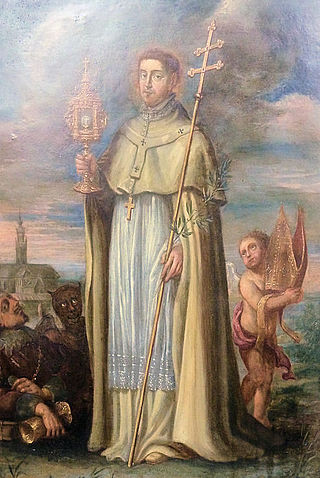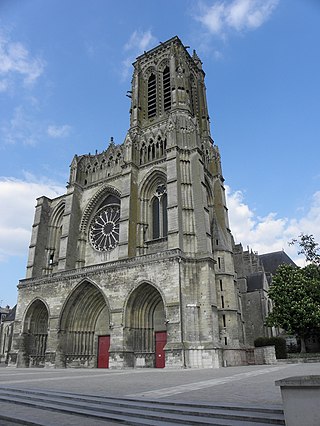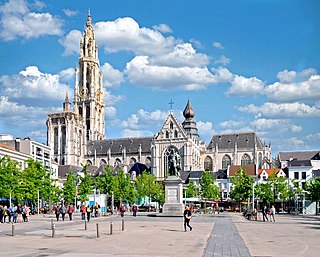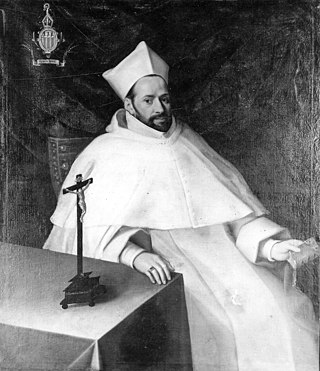
Leuven, also called Louvain, is the capital and largest city of the province of Flemish Brabant in the Flemish Region of Belgium. It is located about 25 kilometres east of Brussels. The municipality itself comprises the sub-municipalities of Heverlee, Kessel-Lo, Leuven proper, Wilsele, Wijgmaal and part of Haasrode and Korbeek-Lo. It is the eighth largest city in Belgium, with more than 100,244 inhabitants.

Norbert of Xanten, O. Praem (Gennep-Magdeburg), also known as Norbert Gennep, was Archbishop of Magdeburg, founder of the Premonstratensian order of canons regular, and is venerated as a saint in the Catholic Church. Norbert was canonized by Pope Gregory XIII in the year 1582, and his statue appears above the Piazza colonnade of St. Peter's Square in Rome.

The Order of Canons Regular of Prémontré, also known as the Premonstratensians, the Norbertines and, in Britain and Ireland, as the White Canons, is a religious order of canons regular of the Catholic Church founded in Prémontré near Laon in 1120 by Norbert of Xanten, who later became Archbishop of Magdeburg. Premonstratensians are designated by OPraem following their name.

Godfrey I, called the Bearded, the Courageous, or the Great, was the Landgrave of Brabant, Count of Brussels and Leuven (Louvain) from 1095 to his death and Duke of Lower Lorraine from 1106 to 1129. He was also Margrave of Antwerp from 1106 to his death.
The States of Brabant were the representation of the three estates to the court of the Duke of Brabant. The three estates were also called the States. Supported by the economic strength of the cities Antwerp, Brussels and Leuven, the States always were an important power before the rulers of the country, as was reflected by the charter of the duchy.

Averbode Abbey is a Premonstratensian abbey situated in Averbode, in the municipality Scherpenheuvel-Zichem, in the Archdiocese of Mechelen-Brussels in Belgium. It was founded about 1134, suppressed in 1797, and reestablished in 1834. Throughout the 20th century the abbey press was a leading children's publisher in Belgium. The church's building is a peculiar synthesis of Baroque and Gothic, with Renaissance ornament details, dominating the monastery complex. The whole structure was built of iron sandstone from Langdorp and white sandstone from Gobertange between 1664 and 1672, after a design by the Antwerp architect Jan Van den Eynde II.
Mont Cornillon Abbey was a Premonstratensian monastery which occupied a site in Wallonia close to Liège, Belgium. In 1288 the abbey having moved to a new location, it became known as Beaurepart Abbey. It was the home of Saint Juliana of Liège.

Floreffe Abbey is a former Premonstratensian monastery, the second of the order to be founded, situated on the Sambre at Floreffe, about 11 km (6.8 mi) south-west of Namur, Wallonia, Belgium.

Prémontré Abbey was the mother house of the Premonstratensian Order and was located at Prémontré about twelve miles west of Laon, département of Aisne, France.

The Diocese of Soissons, Laon, and Saint-Quentin is a Latin Church diocese of the Catholic Church in France. The diocese is suffragan to the Archdiocese of Reims and corresponds, with the exception of two hamlets, to the entire Department of Aisne. The current bishop is Renauld Marie François Dupont de Dinechin, appointed on 30 October 2015. In 2022, in the Diocese of Soissons there is one priest for every 5,594 Catholics.

Tupholme Abbey was a Premonstratensian abbey close to the River Witham some 10.5 miles (16.9 km) east of the city of Lincoln, England and one of nine such abbeys within the historical county. The Witham valley in Lincolnshire is notable for its high concentration of monasteries—there were six on the east bank and three on the west—all presumably drawn to the area by the usefulness of the River Witham for transport and by the wealth that it transported. The abbey was largely destroyed by 1538, after being seized during Henry VIII's Dissolution of the Monasteries.

The Diocese of Antwerp is a Latin Church ecclesiastical territory or diocese of the Catholic Church in Belgium. The diocese was restored in 1961. It is a suffragan in the ecclesiastical province of the metropolitan Archdiocese of Mechelen-Brussels. Its cathedra is found within the Cathedral of Our Lady.

Jan Druys, Latinized Drusius (1568-1634) was a Norbertine canon regular from the Low Countries who became the 30th Abbot of Park Abbey in Heverlee just outside Leuven.

Berne Abbey, a Dutch abbey of the Premonstratensians, or Norbertines, in Heeswijk, North Brabant, is a religious community in the Netherlands. It has 27 brothers and priests.

The Old University of Leuven is the name historians give to the university, or studium generale, founded in Leuven, Brabant, in 1425. The university was closed in 1797, a week after the cession to the French Republic of the Austrian Netherlands and the principality of Liège by the Treaty of Campo Formio.

Dieleghem Abbey or Dielegem Abbey is a former abbey located in the Brussels municipality of Jette, Belgium. It was abolished in 1796.

Daylesford Abbey is a Roman Catholic monastery of Canons Regular of Premontre, located in Chester County, Pennsylvania, about 20 miles west of Philadelphia. The Abbey is named after Daylesford, Pennsylvania, where the Norbertine Fathers established the foundation that developed into the Abbey.

St Gertrude's Abbey is a complex of former monastic buildings in Leuven, Belgium. An Augustinian priory founded in 1206 was suppressed in 1797. After restoration, the monastic buildings were used between 1917 and 1968 by Benedictine nuns as a house of studies and student residence.
Annibal-Servais de Lairuelz, a native of Hainaut in what is now Belgium, was a canon and reformer of the Premonstratensian Order.





















